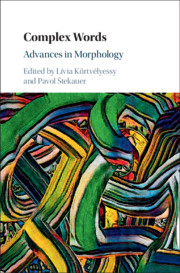Book contents
- Complex Words
- Complex Words
- Copyright page
- Dedication
- Contents
- Contributors
- Introduction: Advances in Morphology
- Part I Lexico-Semantic Aspects of Complex Words
- Part II Structure of Complex Words
- 7 Estonian Case Inflection Made Simple
- 8 Uninflectedness
- 9 Complex Exponents
- 10 Derivational Patterns in Proto-Basque Word Structure
- 11 The Complexity of Greek Verbal Morphology
- 12 Affixoids
- Part III Corpus-Based Case Studies
- Index
- References
8 - Uninflectedness
Uninflecting, Uninflectable and Uninflected Words, or the Complexity of the Simplex
from Part II - Structure of Complex Words
Published online by Cambridge University Press: 18 September 2020
- Complex Words
- Complex Words
- Copyright page
- Dedication
- Contents
- Contributors
- Introduction: Advances in Morphology
- Part I Lexico-Semantic Aspects of Complex Words
- Part II Structure of Complex Words
- 7 Estonian Case Inflection Made Simple
- 8 Uninflectedness
- 9 Complex Exponents
- 10 Derivational Patterns in Proto-Basque Word Structure
- 11 The Complexity of Greek Verbal Morphology
- 12 Affixoids
- Part III Corpus-Based Case Studies
- Index
- References
Summary
I compare and contrast the properties of uninflecting words such as almost, and uninflectable words such as the indeclinable Russian noun kenguru ‘kangaroo’ or the German adjective rosa ‘pink’, which behave like ordinary nouns/adjectives syntactically, but lack the expected inflectional forms. I relate such lexically uninflectable lexemes to the case of inflectable lexemes in constructions which do not permit inflected forms, such as the noun-head noun position in English N-N compounds, or the German predicative adjective (constructional uninflectability). Uninflecting words raise the question of what it is exactly that gets lexically inserted into syntactic representations. I provide a uniform solution to all these questions by appealing to Stump's distinction between content and form paradigms. Uninflecting lexemes have neither type of paradigm; uninflectable lexemes have a content but no form paradigm; construction uninflectability specifies that both content and form paradigms are bypassed. Lexical insertion of a lexeme lacking, or constructionally deprived of, a form paradigm is defined by a maximally general Default Exponence Principle: 'use the root form'. This approach solves all the descriptive and conceptual problems outlined above.
- Type
- Chapter
- Information
- Complex WordsAdvances in Morphology, pp. 142 - 158Publisher: Cambridge University PressPrint publication year: 2020



